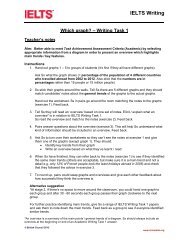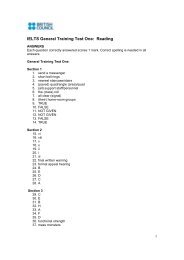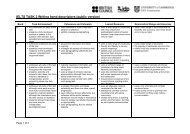IELTS Academic Module preparation > Writing ... - Take IELTS
IELTS Academic Module preparation > Writing ... - Take IELTS
IELTS Academic Module preparation > Writing ... - Take IELTS
You also want an ePaper? Increase the reach of your titles
YUMPU automatically turns print PDFs into web optimized ePapers that Google loves.
) Now complete this description of the process by using words and phrases from the box.<br />
as a result because causes consequently due<br />
give rise to on account of results in<br />
Water leaks slowly into the cave [1………] there are thousands of tiny cracks and holes in the<br />
limestone rock. On its way down, the water absorbs the calcium carbonate present in the rock and<br />
this [2………] a mineral solution. Small drops of this solution form on the roof of the cave. When each<br />
drop falls, it leaves behind a ringshaped deposit of calcite. This process is repeated many times and<br />
[3………] a thin calcite tube is formed. This tube is sometimes called a soda straw [4………] its<br />
shape. Occasionally the soda straw gets blocked [5………] to a piece of stone or soil. This [6………]<br />
the drops of solution to pour down the outside of the straw. [7………], calcite deposits build up<br />
around the straw and these [8………] the typical cone shape of the stalactite. Only the straws that get<br />
blocked will eventually become stalactites.<br />
Activity 4 > Relative clauses > 5 minutes<br />
Relative clauses are clauses in sentences which add information about the subject of the sentence.<br />
Sometimes this is extra information, and the sentence would be correct without the clause. In this<br />
case, we call the clause ‘nondefining’. Look at this example from the description of the lift in Activity<br />
1:<br />
The lift carriage is also forced up.<br />
The lift carriage, which is attached to the top of the piston, is also forced up.<br />
You can see that the clause adds extra information about the carriage, but the sentence is still<br />
grammatical without the clause. Notice that we use commas (,) to separate a nondefining clause<br />
from the main clause. Also, remember that you cannot use ‘that’ as a relative pronoun with nondefining<br />
clauses.<br />
Other clauses add important information which describe or ‘define’ the subject of the sentence. Here’s<br />
an example:<br />
Page 4 of 15







